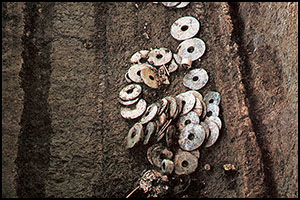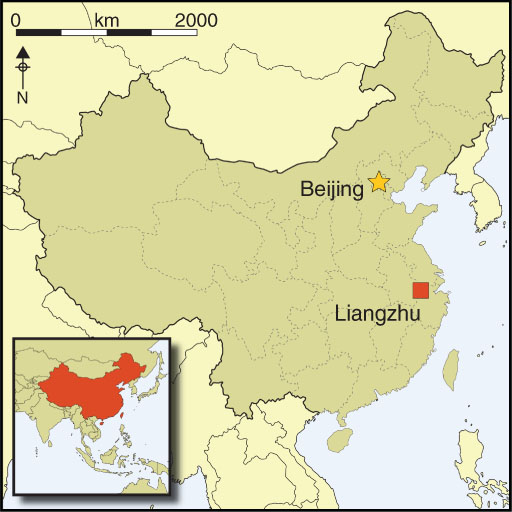
Introduction
The first state society of China has been conventionally regarded as the Shang dynasty, established around 1600 BC, as documented in burials found at Anyang, and subsequently at Erlitou. Research at the site of Liangzhu in Zhejiang Province, 160km west of Shanghai, has, however, documented earth walls enclosing a 300ha (3km2) town area, dating from 3300–2300 BC. The grave goods from the Fanshan cemetery within the town include finely worked jades accompanying high-status burials. The recently investigated earthen dams to the west and north of the site indicate impressive, large-scale hydraulic works. Together these findings suggest the emergence of what may be regarded as a state society. Interestingly, Chinese historiographers later assigned jades of cong form—of the kind found at Liangzhu—to the Zhou and Han dynasties, and all memory of Liangzhu was lost. But it is clear now that these Liangzhu jades were produced in a complex society that flourished more than a millennium earlier than those producing Shang-period bronzes. The Liangzhu jades can now be regarded as the sophisticated products of what may be the earliest state society in East Asia.
Emerging complexity in the Chinese Neolithic
Thirty years ago the leading commentator on Chinese archaeology, Kwang-chih Chang, wrote: “We are in the midst of a Golden Age of Chinese archaeology because we have the opportunity to witness the creation of a completely new body of knowledge concerning the prehistory of a quarter of all humanity” (Chang Reference Chang1986: 412, quoted in Liu & Chen Reference Liu and Chen2012: 392). This comment remains doubly valid, as the Golden Age has continued to the present day. It is now clear that before the Shang dynasty of China, which was traditionally regarded as the inception of Chinese civilisation, there were two millennia during the Late Neolithic period when, in different parts of China, urban societies emerged. The Liangzhu culture is one of these (Huang Reference Huang1992; Chi & Hung 2008). Situated in the valley of the Lower Yangtze River, near Lake Tai (one of China’s largest lakes), and already recognised for the rich burials at Fanshan (Zhejiang 2005a) with their distinctly formalised jade grave goods, the urban nature of Liangzhu (Figure 1) was later revealed by the discovery of its fortification walls (Zhejiang 2009). In the past few years the scale and extent of the hydraulic works associated with Liangzhu, the principal settlement of the region, have been revealed. They include a system of dams, located between 2 and 11km to the north and north-west (Zhejiang 2016), that would have required a considerable labour input. They may be the earliest communal works achieved anywhere in the world on such a scale (Liu et al. Reference Liu, Wang and Chen2016).
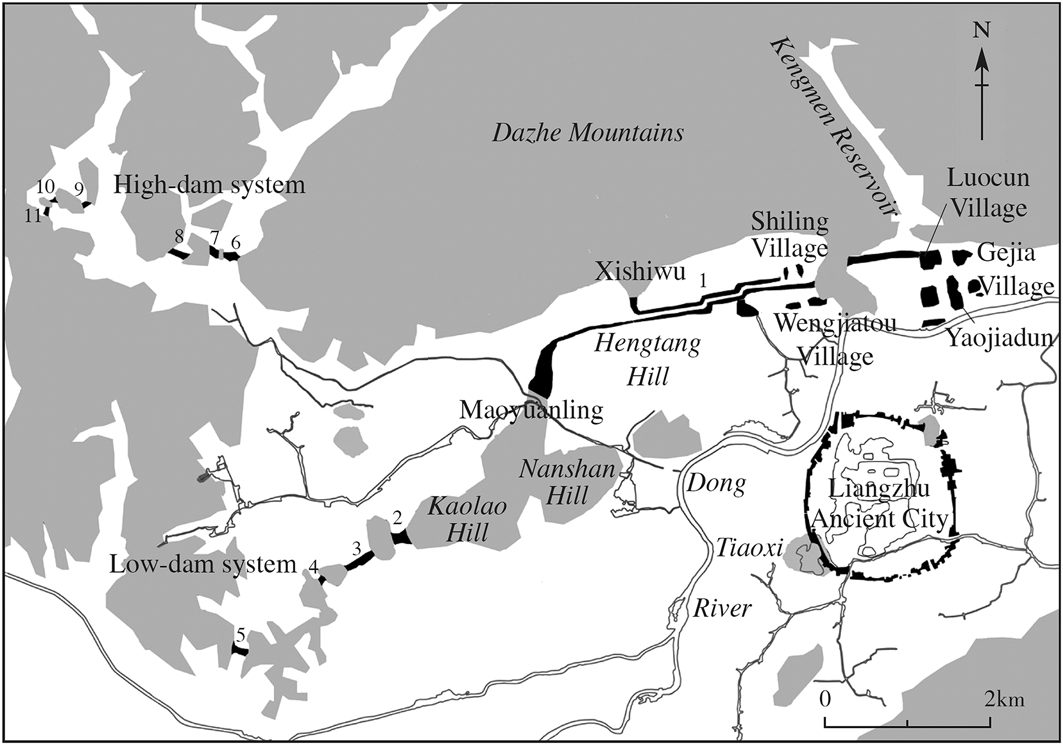
Figure 1 Plan of the town of Liangzhu with neighbouring settlements, showing the locations of the high dams and the low dam at Tangshan.
The most striking products of the Liangzhu culture are undoubtedly the symbolic jade objects, which are found prominently in the richest burials. These jades, which fall early in the long and rich sequence of elaborate artefacts produced over the millennia for the elites of China, are well defined in their types, and are consistent in their decoration. Indeed, when considering an analogue or comparandum for the well-known marble sculptures of the early Bronze Age Cycladic Islands, which are of approximately the same date, the number of formal analogies between the two series of carvings are striking. In both cases, the works in question have been found in cemeteries accompanying rich burials. Each class, whether the marble folded-arm sculptures of the Cyclades, or the jade cong and other forms—notably the bi discs, which are flat and circular with a cylindrical central hole—of Liangzhu, conforms to well-defined and parsimonious visual rules. Each has an iconography that must clearly be related to a belief system for which it provides the limited evidence available. Each product has a simplicity of form, employing only cylindrical and rectanguloid shapes, which, together with the attractiveness of the material itself, makes it pleasing to the modern eye. This has led to the high value set on them by both collectors and looters.
The underlying visual systems in the two cases do indeed have interesting analogies. But, while a decade ago the two societies in question—the Cycladic Keros-Syros culture and the Liangzhu culture of the Lower Yangtze River—might have been considered comparable in a number of ways, recent discoveries show that they were very different in scale (Liu et al. Reference Liu, Wang and Chen2016, Reference Liu, Wang, Chen, Wu, Mo, Liu, Xu and Zhuang2017; Marthari et al. Reference Marthari, Renfrew and Boyd2017). The size of Liangzhu town, 3km2 in area within its fortifications, exceeds anything in the contemporaneous Aegean. The magnitude of the recently documented hydraulic works near Liangzhu, which are greater in scale than the classical Diolkos, the predecessor of the nineteenth-century AD Corinth Canal, exceeds anything in the Aegean until the construction of that impressive successor. The formalism of the Liangzhu jades accompanied a society operating on a much larger scale than did the communities of the Early Cycladic Islands of Greece. If an analogue is sought for the early town of Liangzhu, it may be more appropriate to consider pre-dynastic Uruk in Mesopotamia, or Tell Brak in Syria in the fourth millennium BC.
In The archaeology of China, Liu and Chen (Reference Liu and Chen2012: 213–52) describe the rise and fall of early complex societies in the Late Neolithic of China (c. 3000 BC to c. 2000 BC) and review the Liangzhu culture as representing one of the 15 regional assemblages considered. Several Late Neolithic societies had a settlement hierarchy with three or four levels, and walled sites (usually constructed of rammed earth) are known in the Yellow River region and in the Yangtze River region (Dematté Reference Dematté1999). The site of Taosi in the Middle Yellow River Valley was one of the largest of these—a major centre, with an area of 300ha during the late Longshan period, 2600–2000 BC (Liu & Chen Reference Liu and Chen2012: 222). Liangzhu was of comparable scale.
The development of the Neolithic economy in south China and the Lower Yangtze River Valley is already documented at Kuahuqiao near Hangzhou from c. 5600 BC, and is well exemplified at Hemudu, where rice was grown from shortly after that time (Fuller et al. Reference Fuller, Harvey and Qin2007; Liu et al. Reference Liu, Lee, Jiang and Zhang2007; Zhong et al. Reference Zhong, Chen, Innes, Chen, Wang and Wang2007). Nearer to Liangzhu lies the site of Maoshan, some 20km to the east of the town, where well-structured rice paddy fields have been revealed (Zhuang et al. Reference Zhuang, Ding and French2014). Here the size of the fields increased with the application of manuring, burning and drainage, from less than 30–40m2 in the early phase (2900–2600 BC) to 1000–2000m2 in the later phase (2500–2300 BC). A 400m2 refuse pit was found at eastern Mojiaoshan, within the walls at Liangzhu (see below), containing approximately 13 000kg of charred rice, which was perhaps burnt in a granary located in the palace nearby and subsequently discarded. Fruit crops, including peaches, were also grown in the region (Zheng et al. Reference Zheng, Crawford and Cheng2014). The present article reviews recent discoveries, concluding that the newly documented scale of the dam systems, used for flood control as well as irrigation, and features of the town of Liangzhu itself, establish the Liangzhu complex as the centre of a state society.
The structure of Liangzhu town
The gradual discovery of the complex of sites close to Liangzhu was reviewed by Sun (Reference Sun1993), Su (Reference Su1996) and more recently by Liu (Reference Liu2009) and Qin (Reference Qin2013). The location of Liangzhu itself was first noted and excavated in 1936. The term ‘Liangzhu culture’ was proposed in 1959 by the distinguished archaeologist Xia Nai, and defined initially on the basis of the typical black pottery recovered. It was not until 1986, however, that the elite tombs at the site of Fanshan (with their notable jade artefacts), now known to lie within the walls (Figure 2), were excavated (Zhejiang 2005a). This was followed in 1987 by the excavation of 13 tombs situated on top of a truncated, pyramid-shaped altar at Yaoshan (Zhejiang 2003), approximately 5km north-east of the walls. The cemeteries of Fanshan and Yaoshan did not yield material suitable for radiocarbon dating, but can be dated to c. 3300–2800 cal BC using comparative typology of the ceramic grave goods from the cemeteries at Miaoqian (Zhejiang 2005b: 359–61) and Xindili (Zhejiang 2006: 596–606). The large earthen platform immediately to the east of the Fanshan cemetery, known as Mojiaoshan, measures 630m from east–west and 450m from north–south (Figure 2). It is approximately 9–15m in thickness, its centre being built of layers of sand and rammed earth. This feature was investigated from 1987–1993, and was revealed to be an artificial platform occupying an area of some 300 000m2. Large postholes were found in the central part, indicating structures that are inferred to have formed the palatial complex at the heart of the town. But it was only in 2006–2007 that the remains of the city walls around the Mojiaoshan site, with their accompanying moat, were systematically studied through coring, survey and excavation. Although inconspicuous today, they represent one of the most impressive systems of fortifications of Late Neolithic China. The outermost water system included large aquatic areas to the north-west, the north and the east of the city, which were, in effect, small lakes. At Tangshan, approximately 2km to the north, there is an earth wall, some 5km in length, which formed part of the hydraulic control system for the Liangzhu site. This has only recently been studied more completely (see below).

Figure 2 Plan of the town of Liangzhu with water gates, the Fanshan cemetery and the Mojiaoshan platform.
The town wall of Liangzhu was made of rammed earth, with a foundation of stones that must have been brought in from quarries. It had a rectangular plan, measuring 1900m north–south and 1700m east–west, with rounded corners. The wall is at least 20m in width—and sometimes much wider—surviving in places to a height of 4m. Three of the four walls had both interior and external moats, with only the southern wall lacking the exterior moat. To date, eight water gates have been discovered, two per side, and each between 10 and 60m wide (Figure 2). In the middle of the southern wall there are the remains of the single terrestrial entrance to the town. Internal communication within the town must have been largely by boat; this was a town of canals as much as of roads.
Early water management near Liangzhu
The most substantial component of the water management system north of the town of Liangzhu was discovered and excavated during the 1990s at Tangshan. It is an earthen wall approximately 5km long and 20–50m wide, which is now recognised as a dam to contain the runoff from the Tianmu Mountain to the north. This now emerges as part of a system of low dams, built to control flooding in the alluvial plain, which today lies from 12–20m asl. Several elite burials of the late Liangzhu period were found on top of the dam wall at Tangshan, along with a jade and stone workshop, which confirm the date of the structure. Radiocarbon dates from the grassy (reed) plants used in the ‘sand bags’ employed in the construction of the dam indicate that they were used between 3100 and 2700 cal BC. The dam can now be considered part of a more extensive low dam system, standing some 9m asl, which was extended by a number of smaller dams to the west. When full it could support water traffic for a distance of 3.7km upstream, extending to the base of the recently discovered Ganggongling high dam. This is part of a separate system of dams, strategically placed to create an upper reservoir lying upstream, at an altitude 16m above that of the Tangshan dam.
This series of five high dams was discovered in 2009, the first lying near Gangongling, 8km north-west of Liangzhu. They have been investigated by remote sensing, assisted by the analysis of high-resolution Corona and Google Earth images, and followed by coring, survey and excavation. The five dams, some of which survive to a height of 10m, form two clusters, each dam between 50 and 200m long at the top. This configuration produced two lakes situated some 25–30m and 35–40m, respectively, asl (Figure 3). The oval-shaped, straw-wrapped silt blocks (each approximately 0.4m in length) of which the dams were built can be seen in section, stacked on top of each other. Together, these high dams created reservoirs, which, when full, spread 1.5km upstream. The total storage volume has been calculated as approximately 50 million cubic metres.

Figure 3 The upper earth dam at Laohuling above Liangzhu (photograph by Bin Liu).
Although their main function may have been to prevent sudden flooding from seasonal rainfall, and to provide controlled flow for the irrigation of rice paddy fields, the lakes (when full) will have also been important for transportation purposes. Large quantities of wood were needed to frame the structures recorded in Liangzhu town (for example, timber for the postholes of the palace on the Mojiaoshan earth platform). These logs will have been floated down to the site of Liangzhu using this well-conceived system of lakes, dams and waterways.
The systematic documentation of these systems of hydraulic work—both the high dams and the much more extensive low dam system, all of which were completed before 2500 BC—establishes this as one of the earliest major hydraulic schemes known, perhaps exceeding in scale those of the ‘hydraulic civilisations’ of Egypt and Mesopotamia (Adams Reference Adams1966; Butzer Reference Butzer1976; Menze & Ur Reference Menze and Ur2012). The chronology has been confirmed by a series of 12 AMS radiocarbon dates taken using annual grassy plants and bamboo from the dams, in some cases from the straw wrappings of the constituent earthen blocks. Dating suggests that most were used between 3200 and 2600 cal BC (Zhejiang 2016: 117). The organisation implied by these impressive systems of hydraulic engineering was considerable. One estimate suggests that the amount of earth used for the Tangshan dam alone was in the order of two million cubic metres (Liu et al. Reference Liu, Wang, Chen, Wu, Mo, Liu, Xu and Zhuang2017).
Jade artefacts from Liangzhu and the evidence for elite burial
The jade artefacts of the Liangzhu culture are all of nephrite, which was probably available locally (although the precise source has not yet been established). They fall into a number of distinct categories, and their decorative motifs form a well-defined, yet very limited, repertoire (Liu Reference Liu1998; Tang Reference Tang2015). Both artefact types and decorative motifs are stylised: the specific forms of the artefacts (including those of the bi, the cong and the like) and of the incised decoration, notably the motif seen on the cong, are repeated with little variation. The realisation that the town of Liangzhu with its associated hydraulic works was of a scale and elaboration appropriate to a distinctly complex society (perhaps even a state society) gives these artefacts a special significance. This is all the more marked as the other artefacts of the Liangzhu culture, including the ceramics, are not of any notable sophistication. The elite burials of the Liangzhu culture offer some interesting insights into the social organisation and symbolic systems of the time, and here the jades are particularly informative.
It was not until 1973 that excavations revealed the first recorded tombs of the Liangzhu culture, although not at Liangzhu itself, but rather at the site of Caoxieshan in the province of Jiangsu. These tombs contained not only characteristic black pottery, which had already been recognised, but also ritual jades, including the cong, so-called ‘prismatic’ tubes with a square exterior and a cylindrical interior, and the bi discs (Childs-Johnson Reference Childs-Johnson2010). Chinese scholars had previously attributed these artefacts to the Zhou to Han periods (Wilson Reference Wilson2017), but they could now be dated to the Late Neolithic period. In the following years, impressive tombs were found at the Sidun site in Jiangsu province, and then at Fuquanshan near Shanghai. Then, in 1986, the Fanshan cemetery (Figure 4), with its exceptionally rich series of jades, was discovered: it was later understood that this was located within the enclosing walls and moat of Liangzhu town itself.

Figure 4 Plan of tomb 12 at Fanshan (from Zhejiang 2005a: vol. I, 29). Length of inner coffin: 2.92m.
The finds from the Fanshan cemetery have been well published in two richly illustrated volumes (Zhejiang 2005a). They have been concisely summarised by Sun (Reference Sun1993: 20):
A small, man-built earthen mound, Fanshan, measures 90m east–west by 30m north–south, and is some 4m high. At the west of the mound, 11 tombs were found in 2 parallel rows, which yielded over 3000 jades [Figure 5]. Tomb M20, the most lavishly furnished, produced over 500 jades, while even the least furnished tomb yielded over 50 jades. Among the jades were 125 bi and 21 cong. The most extraordinary find was a cong (nicknamed ‘the king of cong’ (M12:98)). It measures 8.8cm in height and 17.6cm in width, and weighs 6.5kg. No less impressive than its size are the 16 elaborate double images engraved on its four sides [Figure 6]. The image depicts a semi-human figure holding a fearsome mask with protruding teeth. This double image shows a certain consistency with the simpler superimposed face motifs found on many other Liangzhu jades. In some tomb pits at Fanshan, traces of decomposed wood and remains of a red coating material were found. This confirmed the discovery already made at Fuquanshan that burial caskets or coffins were used in the Liangzhu period.

Figure 5 Bi discs in tomb 23 at Fanshan (photograph from Zhejiang 2005a: 338).
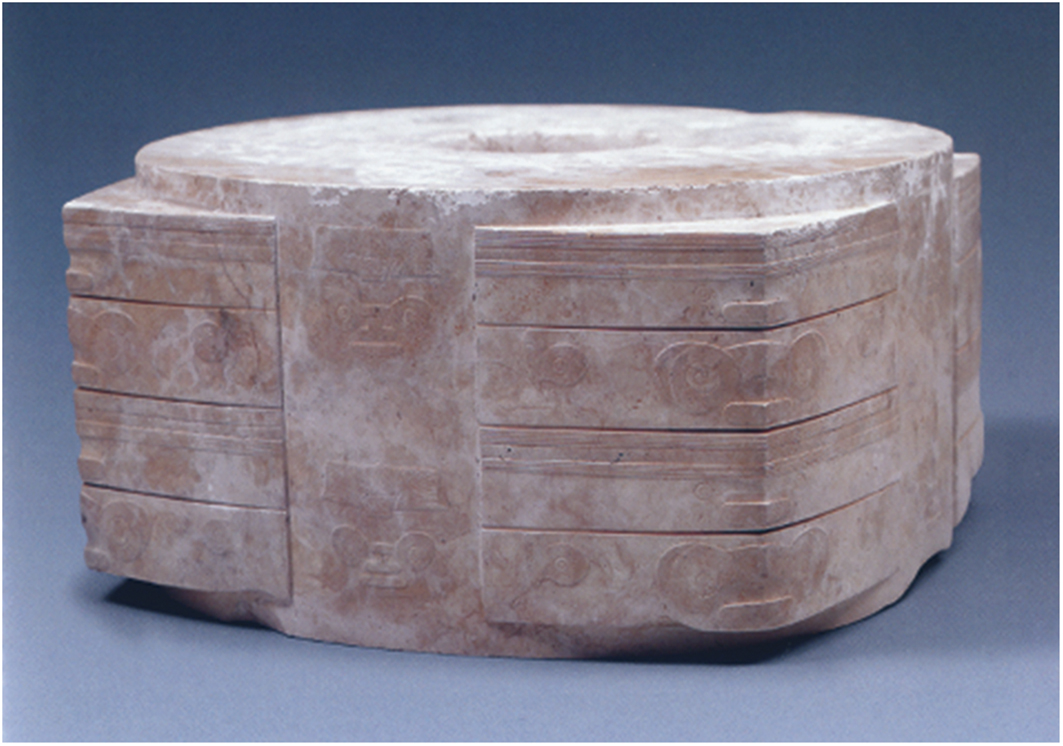
Figure 6 Jade cong from tomb 12 (M12:98) at Fanshan; width: 180mm, height: 89mm (from Zhejiang 2005a: vol. II, 43 & 46).
As already mentioned, Fanshan lies adjacent to the Mojiaoshan earth platform, where evidence for palatial buildings was found. Fanshan was the most important of the three cemeteries found within the walls of the town; the rich burials of Yaoshan were found 5km north-east of the town; at Huiguanshan, 2km west of Fanshan, another earthen altar (similar to the one at Yaoshan) was uncovered with four large tombs. Excavations in the region have revealed a number of other sites where middle-rank and lower-rank cemeteries were discovered along with nearby residential buildings.
The high standard of publication of the Fanshan and Yaoshan cemeteries (Zhejiang 2003, 2005a) makes it possible to examine the high degree of patterning in the grave goods assemblages of the 11 tombs at Fanshan and the 13 at Yaoshan, and in the design of the artefacts themselves. As skeletal preservation at Fanshan was poor, the graves could not be classified by age or sex through osteological analysis. These were single inhumation graves, with the corpse extended, the head to the south. As Rawson (Reference Rawson1995: 123) states, the marked patterning of grave goods seen within a rich Liangzhu culture cemetery, such as Fanshan, is not closely repeated at a nearby cemetery, such as Yaoshan, which has its own local conventions. Caution should, therefore, be exercised in thinking or assuming that the same conventions applied across the territorial range of the Liangzhu culture: the opposite may, in fact, have been the case, and some local conventions may have prevailed at individual burial sites. For instance, the graves at Fanshan are notable for the large number of bi that are found (Figure 5); in contrast, Yaoshan yielded no bi. Many graves at both cemeteries contained, among other artefacts, a single ceremonial axe (yue) originally mounted on a wooden haft (usually not preserved), with a beautifully carved jade terminal at both the top and the base of the shaft. In many cases, a grave may contain several other axes, but these are not usually made of the uniform cream-coloured jade used for the finest items. Instead, they comprise variegated and sometimes multi-coloured jade, which often resembles the jade used for the bi. In the absence of preserved human remains, it has been inferred that the graves containing single jade yue, sometimes with the jade mounts on the haft, are male graves.
Another frequent grave accompaniment is a flat trapezoidal jade artefact, which is sometimes pierced by four parallel holes, and occasionally bears an incised man/beast motif (see below). The positioning of these artefacts in the grave suggests that they formed part of a headdress. Additionally, D-shaped plaques with the aforementioned man/beast motif on one side occur at Fanshan but not Yaoshan. The other side has a series of interconnected holes by which it could have been sewn onto something, perhaps the outside of a hat or headdress. The trapezoidal jade plaque is often accompanied by a three-pronged artefact, which is also occasionally decorated with the man/beast motif, and by a quantity of jade awl-shaped ornaments (numbering 3, 5, 7, 9 or 11, depending on the rank of the cemetery). Each of these is pierced at one end to form a pendant. The elite clearly had very elaborate headgear.
The elite cemeteries of the Liangzhu culture (Fanshan being the richest) generally contain up to 20 graves. They presumably represent the burials of the upper echelon of society. At Fanshan, these may indeed be the graves of the rulers of Liangzhu town itself. Outlying cemeteries with rich jades must again represent an elite, but how they related in administrative or familial terms to the burials at Fanshan is not yet clear.
The man/beast motif on the Liangzhu culture jade artefacts
The decorations on the various Fanshan jade artefacts are mainly variations or abbreviations of a single complex motif seen most clearly and in detail on the jade cong M12:98 from tomb 12 (Figures 7–8). Rawson (Reference Rawson1995: 122) comments:
The faces are derived from a combination of a man-like figure and a mysterious beast. The man stands behind and above the monster, appearing to ride on it or to grasp it by its large oval eyes. In such fully detailed examples the man wears a plumed headdress, and the monster has a large fanged jaw. In abbreviated examples the two forms can be recognised from their eye shapes: the man has round eyes with slight points at the corners, and the pupils are indicated by a central drilling; the monster is suggested by large oval eyes, a wide nose and sometimes a wide mouth. Below the monster, a pair of limbs ending in claws can sometimes be seen. Complex versions of the monster face are criss-crossed by fine intaglio lines. The lines may be quite widely spaced, giving a strong, almost threatening effect, as on a bracelet cong from tomb M9 at Yaoshan. But the majority of the most elaborately worked pieces have densely packed, fine incised lines. The designs are meticulously executed, the entire motif occupying only a few square centimetres.
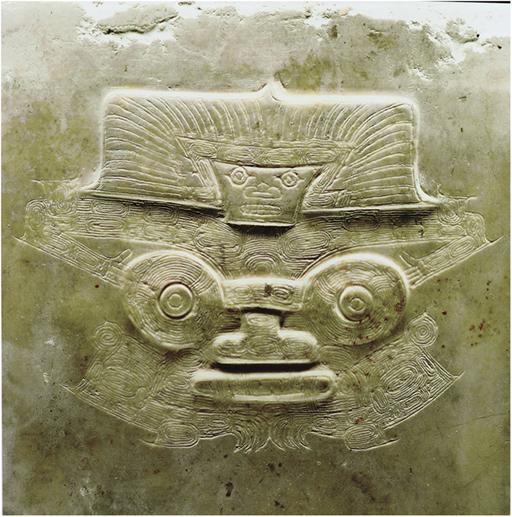
Figure 7 The man/beast motif on the principal cong (M12:98) from tomb 12 at Fanshan; height: approximately 30mm (from Zhejiang 2005a: vol. II, 56).

Figure 8 Drawing of the man/beast motif on the principal cong from tomb 12 at Fanshan; height: approximately 30mm (from Zhejiang 2005a: vol. I, 56).
This motif is seen on several of the jade cong at Fanshan, and also on jade cylinders and other fittings. Significantly, it is also seen (Figure 9) on both sides of the blade of the special jade yue, which was found along with the jade fittings for the top and bottom of the haft, in tomb 12 (M12:100). Given that axe or adze blades do not usually have any decoration, this piece is altogether exceptional. As on the blade from tomb 12, the man/monster mask motif is often accompanied by an incised bird’s head, recognisable by its beak. This is visible standing out above the surface of the axe (which has, in reality, been reduced over much of the axe to produce the raised motif effect).

Figure 9 Ceremonial axe (yue) from tomb 12 at Fanshan; length: 180mm (from Zhejiang 2005a: vol. II, 127).
It is striking how this man/beast motif, whether in full detail or in abbreviated form, dominates the decoration of the Liangzhu culture jades. It appears not only on the various cong, such as at Yaoshan and Fanshan, and on the jade axe from Fanshan (M12:100), but also on the trapezoidal plate fittings that are found in many graves, and on a number of cylindrical objects (e.g. M20:3 from Fanshan). There has been much speculation as to whether this design may represent a deity or a shaman (Childs-Johnson Reference Childs-Johnson2010; Liu Reference Liu2013). A social rather than religious explanation could, however, be possible. This was the case for the Early Cycladic folded-arm figure, which has been regarded as an icon or logo for the Confederacy of Keros (Renfrew Reference Renfrew2013). It would similarly be possible to interpret the man/beast motif in social terms, as representing the corporate community of Liangzhu town, or perhaps even the wider social unit occupying the territory of which Liangzhu may have served as centre. In any case, this recurring motif entirely dominates the decoration of the jade artefacts of the Liangzhu culture. Although small models of birds, fish and tortoises are (rarely) found, the man/beast icon holds a dominant place in the iconography.
Re-assessing the emergence of early complex society in China
Three factors could now lead to a reassessment of Liangzhu as representing a state society, despite the absence of writing. For Kuzmin et al. (Reference Kuzmin, Jull and Burr2009), however, that absence precludes such a designation. For although small clusters of signs and individual signs, which could well be regarded as pictographs, are found on pottery and other artefacts from Liangzhu (Liangzhu 2015), no single cluster has sufficient indications to qualify as a writing system. The first significant factor is the size of the town, both within and outside the fortifications. The second is the social ranking (or perhaps stratification) documented in the cemeteries, and the remarkably sophisticated jade artefacts found exclusively in the elite burials. And the third is the scale of the public works achieved, not only in the construction of the Mojiaoshan platform, but also in the high dams and low dams, which together were used to control monsoon runoff from the hills. Many of the criteria considered by V. Gordon Childe (Reference Childe1950) as together representing the Urban Revolution are well documented at Liangzhu, perhaps at a scale and complexity beyond those encountered in chiefdom societies (Sahlins Reference Sahlins1968; Service Reference Service1968). It is this combination of factors that argues for a higher level of organisational complexity than is reflected in the monumental constructions of Neolithic Britain (Renfrew Reference Renfrew1973), or in the finery of the burials at Varna (Renfrew Reference Renfrew1978).
In the light of these recent discoveries, it now seems clear that a sophisticated and complex society had already emerged in the Lower Yangtze Valley by approximately 3000 BC—over a millennium before the appearance of urbanism accompanied by rich Xia- and Shang-dynasty burials at Erlitou and Anyang (Liu & Chen Reference Liu and Chen2003: 57). Liangzhu’s sophistication is most clearly seen in the jade artefacts accompanying the elite burials. These seem to speak to a near obsession with the formalised and standardised man/beast motif, which holds such a single-minded predominance in the iconography. The Liangzhu culture, however, suffered a major decline in the later third millennium BC (Zhang et al. Reference Zhang, Huang, Han, Snape, Meredith, Zhao, Du, Chen and Sun2015), and most of its prosperous urban centres were abandoned or fell into decline. The reasons for this are much contested, but may well have a climatic explanation, perhaps connected with pervasive and systematic flooding. At its zenith, Liangzhu was a town of canals, rivers and lagoons: increasing rainfall may have posed insuperable problems at the end of the third millennium BC. These were conceivably associated with what has been termed ‘the 4.2ka cal BP event’ (see Wiener Reference Wiener2014).
The characteristic forms of the jade artefacts, notably the cong and the bi, were not forgotten, but continued beyond the Shang period when jade cong are still found in high-status burials (Wilson Reference Wilson2017), although they were then perhaps surpassed in importance and value by elite bronze objects, which became prominent at that time. The dominating man/beast motif disappears at the end of the Liangzhu culture, although birds and animal masks are still found on Shang-period jades. The jades of the Liangzhu culture offer an intriguing glimpse into the preoccupations of what was possibly the first state society of East Asia.
Acknowledgements
The first author is grateful to the Hangzhou Liangzhu Archaeological Site Administrative District Management Committee for the kind invitation to revisit the site; to Shoutian Chen for organising the visit and suggesting the present article; to Huiru Lian for acting as translator; and to archaeologists Weidong Jiang and Ningyuan Wang, for much useful information.


